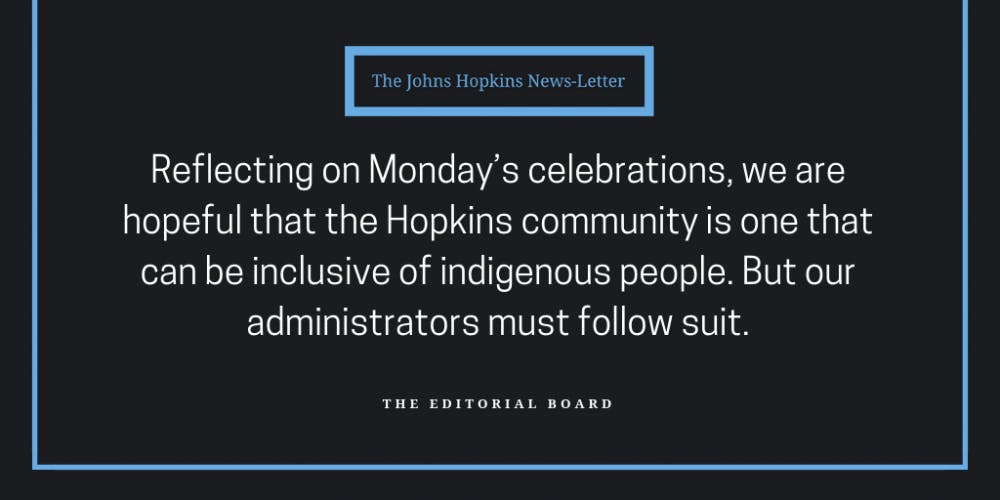Indigenous students at Hopkins have worked tirelessly for the past two years to establish a stronger presence on campus and honor their heritage. In 2016, many indigenous students joined a burgeoning nationwide movement to replace Columbus Day with Indigenous Peoples Day. In 2017, the group Indigenous Students at Hopkins (ISH) formed under the Office of Multicultural Affairs (OMA).
On Monday, Indigenous Students at Hopkins celebrated Indigenous Peoples Day. The celebrations featured a pow wow on Keyser Quad with music, dancing and food. The event featured keynote speaker Victoria O’Keefe, a member of the Cherokee and Seminole nations who examined how historical trauma and racism have been detrimental to the mental health of indigenous communities.
The celebration of Indigenous Peoples Day on campus makes us hope that Hopkins is becoming a more diverse and inclusive university. But we can’t expect indigenous students to carry that burden alone. We have to remember that the University must also take action.
Institutions of higher education in the U.S. have generally underserved indigenous students, arguably more so than other minorities. While indigenous people make up only 1.01 percent of the U.S. population due to our nation’s history of genocide and colonialism, statistics show that their enrollment rates are lower than that of minorities and white people.
According to the National Center for Education Statistics, as of 2016, 42 percent of 18 to 24-year olds who were white were enrolled in colleges. Within that same age group, 36 percent of black people were enrolled, as well as 39 percent of Hispanics, 58 percent of Asians, 42 percent of multiracial people and 21 percent of Pacific Islanders. Of those that the study categorized as American Indian/Alaska Native, only 19 percent were enrolled.
The University could address such inequities by proactively recruiting prospective indigenous students each year. In the Class of 2022, our current class of freshmen, only 24 students identify as “Native American and Pacific Islander” out of a total of 1,319 students. This represents 1.8 percent, similar to the demographics of our peer institutions like Northwestern University and Washington University in St. Louis (1.2 percent and one percent, respectively). In previous years, indigenous students have comprised less than one percent of an entire class; we acknowledge that the Class of 2022 marks an improvement.
But the fact that we are not necessarily behind peer institutions does not mean that we can’t do more. Dartmouth College, which actively recruits indigenous students through its Native American Community Program, has 46 indigenous students out of a total of 1,169 students in its Class of 2022 — about 3.9 percent. This is not a particularly large percentage, but it does show that taking steps to recruit indigenous students pays off and that Hopkins can raise its standards.
The University should consider implementing a program similar to the American Talent Initiative, a collaboration among colleges to seek out and enroll high-achieving low-income students, but specifically design it to increase the enrollment and graduation rates of indigenous students.
In addition to recruiting more indigenous students, the University also needs to establish a variety of resources to ensure that they can thrive academically, socially and emotionally once on campus.
To begin with, the University should make an effort to hire indigenous faculty and staff. Currently, we have no indigenous faculty. We also do not have any indigenous staff members working at OMA. As an office that is “committed to enhancing the educational experience of students from underrepresented populations,” OMA should have indigenous staff who could make indigenous students feel more welcome and supported during their time at Hopkins.
Moreover, upon hiring indigenous faculty members, the University should introduce more coursework on indigenous culture. This could include courses from a wide range of disciplines, including history, literature, art history and sociology.
Some members of academia may question whether such courses are worthy of serious study. They may believe that these courses do not cater to the traditional “canon” or teach mainstream subjects. Historians, in particular, often invalidate Native American history because much of it is passed down orally. In this country and in this political climate, education should focus on countering the ignorance that engenders prejudice. We must confront America’s troubling history.
It’s especially imperative that diversity initiatives be inclusive of indigenous students. Racism and prejudice directly contribute to poor mental health in indigenous communities. Out of all ethnic groups in the U.S., indigenous youth have the highest rate of suicide, and suicide is their second leading cause of death. It is worth the University’s time, effort and resources to make even a marginal improvement in representation for the well-being of the students we have on campus now.
Reflecting on Monday’s celebrations, we are hopeful that the Hopkins community is one that can be inclusive of indigenous people. But our administrators must follow suit. Instead of relying solely on the efforts of indigenous students to make our campus more diverse and inclusive, the University must do all it can to show indigenous students that their efforts will culminate in real progress.





